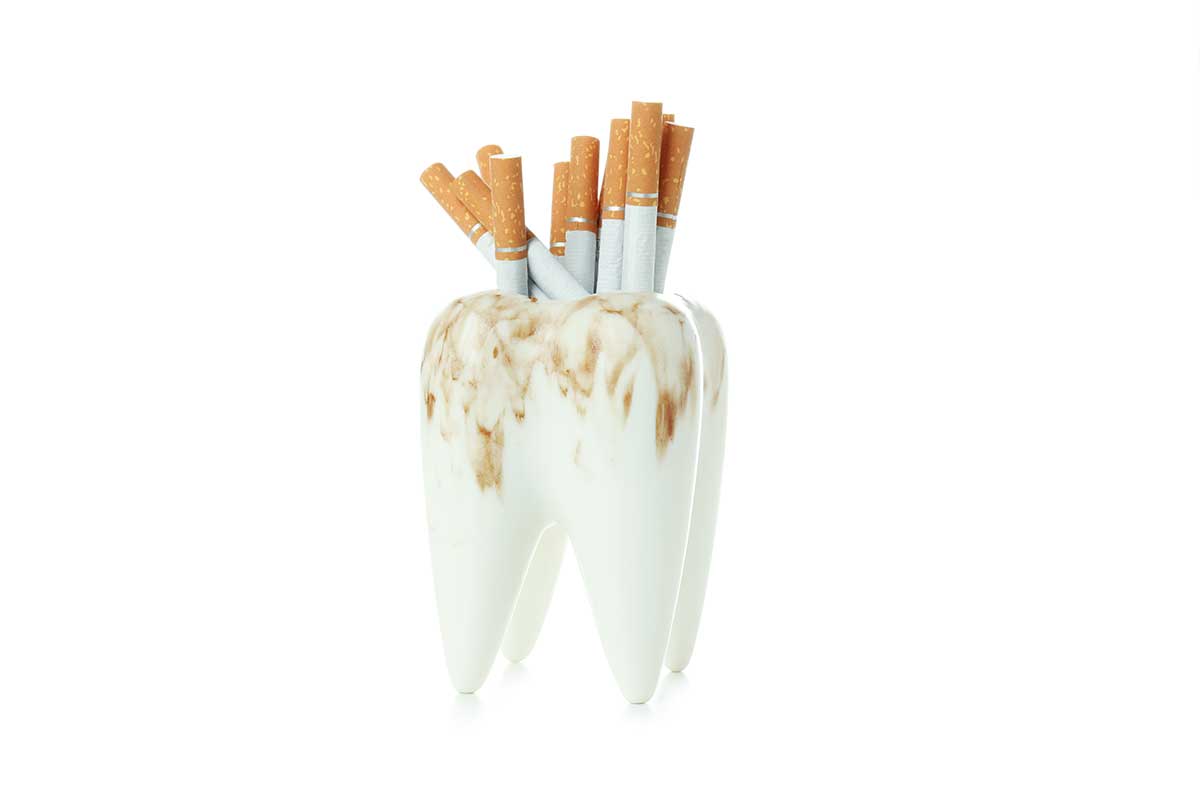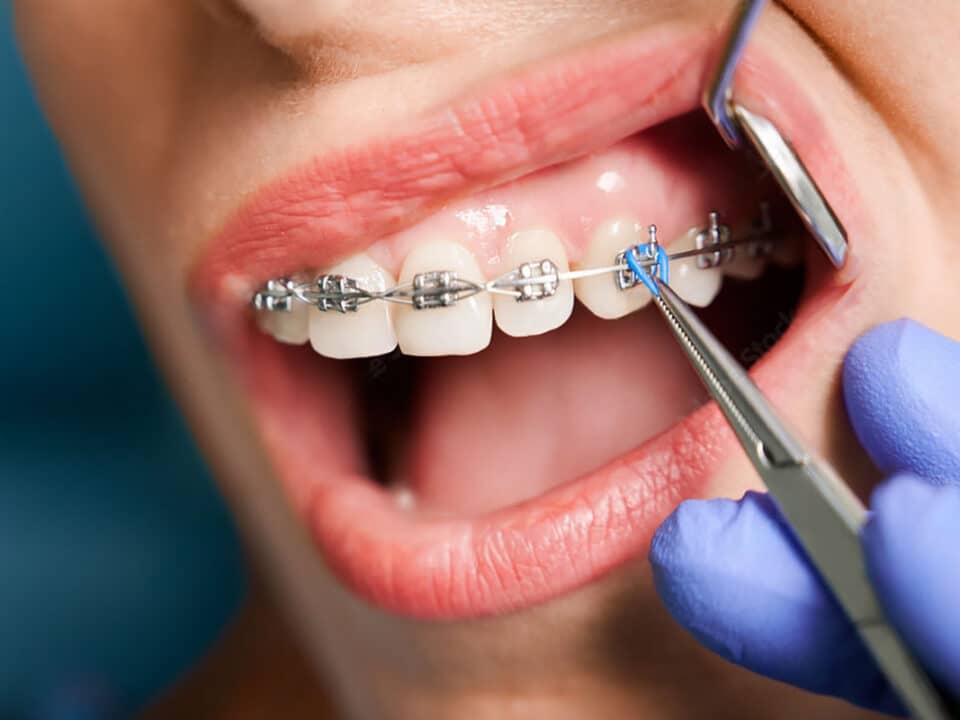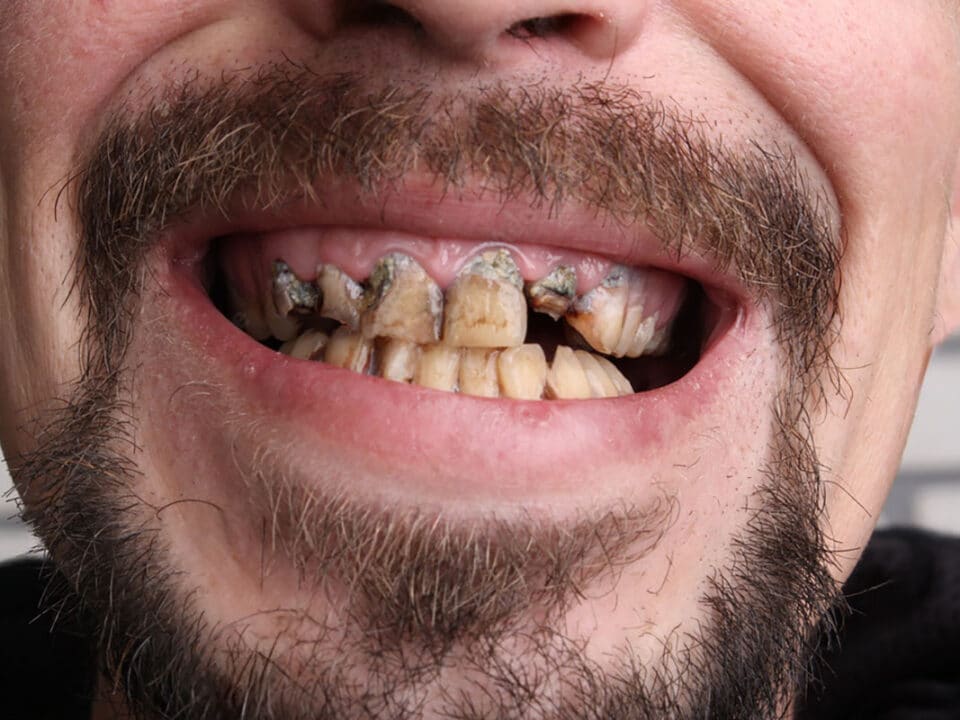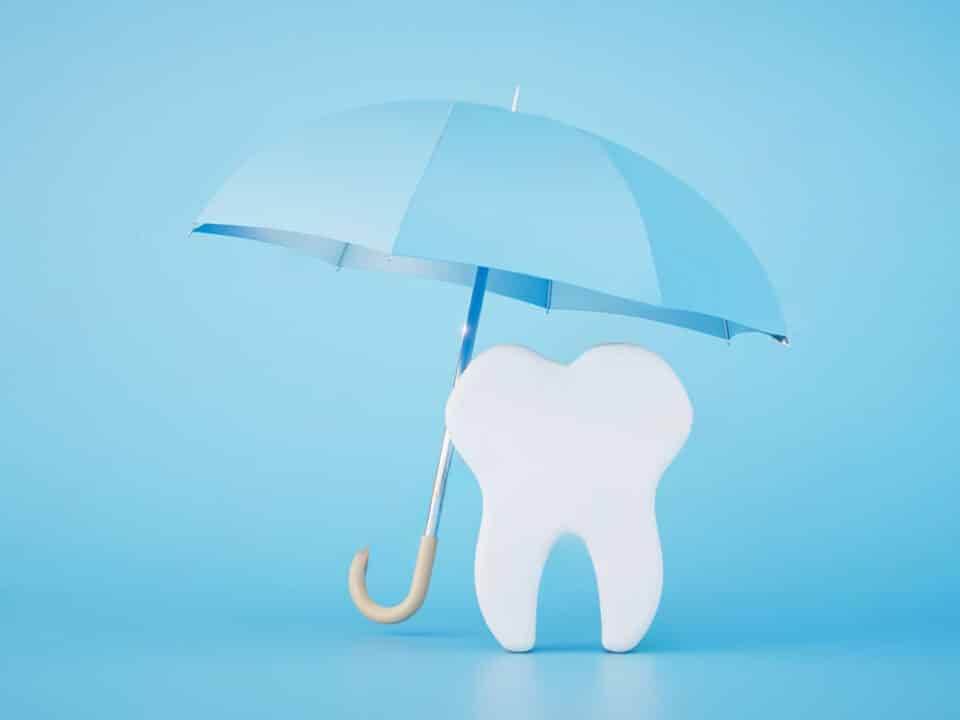Smoking is widely acknowledged as detrimental to overall health, but its specific impact on oral health is often underestimated. From a dentist’s perspective, the consequences of smoking on teeth and gums are both profound and multifaceted. It leads to problems like tooth discoloration, gum disease, and increased risk of oral cancers. Smoking interferes with the normal function of gum tissue cells and can affect bone and soft tissue attachment to your teeth. This can increase the risk of periodontal diseases and, if left unchecked, can lead to tooth loss.
As dental professionals, we do not condone smoking due to its harmful effects.
However, we recognize that people choose to smoke for various reasons. Our role is to provide the best care possible, striving to mitigate the impact of smoking on oral health. When asked how to keep teeth white even if you smoke, we emphasize preventative care and regular check-ups to manage and minimize the damaging effects of smoking on the teeth and gums. We also try to educate our patients on how to keep their teeth white even if they smoke because the process will ultimately positively impact overall oral health, compared to smoking and not taking the extra measures to keep teeth clean and white.
Table of Contents
Why smoking affects your teeth

The detrimental impact of smoking on dental health primarily stems from the harmful chemicals present in tobacco, notably nicotine and tar. These substances are notorious for their ability to adhere to the teeth, resulting in unsightly yellowish-brown discolorations. Furthermore, when combined with saliva, these chemicals create a clingy residue that exacerbates the staining. Additionally, smoking significantly affects gum health, exposing them to potential damage and disease.
As mentioned, smoking stains teeth through a process primarily driven by the presence of nicotine and tar in tobacco. These substances are inherently colourless, but when exposed to oxygen, they turn yellowish and brownish, leading to teeth discoloration. As a smoker inhales, these chemicals are deposited on the surface of the teeth, embedding themselves in the microscopic pores of the enamel. Over time and with continuous exposure, these stains can penetrate deeper into the tooth enamel, making them increasingly difficult to remove. The tar, in particular, is a sticky substance that adheres strongly to the teeth, further contributing to the stubbornness of the stains. This discoloration is often more pronounced along the gum line and between teeth, where smoke particles accumulate most. As a result, regular smokers commonly experience a yellowing or browning of their teeth, which is a direct consequence of these tobacco by-products.
Addressing dry mouth and bad breath
A lesser-known but equally concerning effect of smoking is the induction of dry mouth, essentially reducing saliva production. Saliva plays a pivotal role in oral health, not only aiding in cleansing food particles but also neutralizing harmful acids that contribute to tooth decay and gum disease. The reduction in saliva due to smoking can, therefore, escalate the risk of these oral health issues. Moreover, smokers often struggle with halitosis or chronic bad breath, which further underscores the importance of maintaining oral hydration and cleanliness.
Understanding the long-term consequences
Over time, the adverse effects of smoking on oral health can accumulate, leading to serious conditions such as increased susceptibility to gum disease, a higher likelihood of tooth loss, and even an elevated risk of oral cancer. These long-term consequences represent a significant threat to overall oral health and well-being. Recognizing and understanding these risks is the first step towards mitigating them and maintaining a healthier mouth despite the challenges posed by smoking.
How to keep teeth white even if you smoke

Daily oral care routine
One of the most effective ways to keep your teeth in the best shape possible as a smoker is to stay ahead of the game, so to speak. This means keeping a thorough and regular oral hygiene routine.
Brushing: More than just a morning ritual
Regular brushing is essential in combating tobacco stains. Brushing your teeth at least twice a day goes a long way in maintaining oral hygiene and combating the effects of smoking on your teeth. However, for smokers, sometimes even this might not be enough. We’ll discuss how you can optimize your brushing routine and the types of toothpaste that can give you an extra edge in keeping your teeth white.
Flossing: The unsung hero
Flossing plays a crucial role in oral hygiene, especially for smokers. It reaches the areas where your toothbrush can’t, removing trapped particles of tobacco and plaque. In this section, we’ll go over the right flossing techniques and how flossing properly and regularly can significantly impact the prevention of tobacco-related stains and overall oral health.
The best toothpaste for smokers
For smokers, selecting the right toothpaste is crucial to address specific oral health concerns such as increased plaque and tartar buildup, higher susceptibility to gum disease, and the challenge of tobacco-induced tooth discoloration.
The best toothpaste for smokers typically contains certain key features. Firstly, it should have effective stain-removal properties.
Smoker-specific toothpaste often includes more robust abrasive agents capable of tackling the stubborn tobacco stains that can accumulate on tooth enamel. However, these abrasives should be balanced to ensure they are effective without being overly harsh to avoid enamel erosion.
Additionally, toothpaste with tartar control ingredients is beneficial, as smokers are more prone to tartar buildup, which discolours teeth and can contribute to gum disease.
Including fluoride is essential, as it strengthens tooth enamel and helps prevent decay, a vital aspect for smokers at increased risk of dental caries.
Some toothpaste for smokers may also contain ingredients like triclosan to combat bacteria or specific compounds to neutralize odours, addressing the issue of bad breath commonly associated with smoking. It’s also advisable for smokers to consider toothpaste with anti-inflammatory properties to support gum health.
Ultimately, the best choice of toothpaste for a smoker provides a comprehensive approach – tackling stains, protecting against decay, and supporting overall oral hygiene. Regular consultations with a dental professional can also guide smokers to a toothpaste that best suits their needs.
The best toothbrush for smokers
As a smoker, choosing a proper toothbrush isn’t as vital as toothpaste. We recommend an electric toothbrush with a head designed for plaque removal or whitening. Electric toothbrushes are often more effective and easier to use correctly. Some even come with specific modes to whiten teeth or remove more plaque.
Mouthwash: A vital addition
Incorporating good mouthwash into your oral hygiene routine can provide additional protection against tobacco stains. We’ll explore how mouthwash can help remove lingering tobacco particles and keep your mouth fresh and clean.
Professional dental care
Regular dental checkups
Regular visits to the dentist are even more crucial for smokers. Professional cleanings can help remove tobacco stains and plaque buildup that regular brushing and flossing might miss.
Professional whitening treatments
For those looking for more immediate results, professional whitening treatments can be an effective option.
Deep cleaning and scaling
For those who have been smoking for an extended period, deep cleaning and scaling at a dental office can be essential. These procedures go beyond regular cleaning and can significantly reduce tobacco stains and tartar buildup.
Lifestyle adjustments for smokers
Smoking cessation: A game changer for oral health
While this guide focuses on maintaining white teeth despite smoking, it’s important to touch upon the ultimate solution – quitting smoking. Giving up smoking can dramatically improve not just the colour of your teeth but your overall oral health.
Dietary changes: You are what you eat
Your diet can be a game-changer. We’re not saying you need to eat like a rabbit, but some foods can help combat the effects of smoking on your teeth.
The power of fruits and vegetables
Nature’s toothbrushes, fruits, and veggies can be surprisingly effective in keeping your teeth clean. They’re like nature’s little scrubbers, working away whenever you munch.
Hydration and oral health
Staying well-hydrated is crucial for smokers. Water helps to rinse away tobacco particles and reduces the risk of dry mouth, a common issue among smokers that can exacerbate dental problems.
How can your dentist help keep your teeth white if you smoke?

Dentists play a pivotal role in maintaining white teeth and oral health for smokers. This begins with regular professional cleanings, which are crucial for removing plaque and tartar that can retain tobacco stains. Dentists use specialized tools and polishing agents during these cleanings to effectively lift surface stains, restoring the teeth’s natural colour.
Beyond cleaning, dentists provide customized oral hygiene advice tailored to smokers, including recommendations on specific types of toothbrushes, toothpaste designed for stain removal, and flossing techniques.
Professional teeth whitening treatments offered by dentists are more potent and long-lasting than over-the-counter products, employing higher concentrations of bleaching agents under controlled conditions for significant results.
In addition to these treatments, dentists focus on preventative care and education, highlighting the impacts of smoking on oral health, including increased risks of gum disease and oral cancer, and conducting regular screenings for these conditions.
Smokers often struggle with dry mouth, which can exacerbate tooth decay and discoloration; dentists can recommend products to manage this, such as saliva substitutes, and suggest ways to stimulate saliva production.
In cases where smoking has caused considerable staining or damage, restorative treatments like veneers or crowns might be suggested.
Lastly, regular check-ups allow dentists to closely monitor the oral health of smokers closely, identifying and addressing issues early on, which is essential for preventing serious problems that can affect both the colour and health of the teeth.
Overall, a dentist’s role in caring for a smoker’s oral health is comprehensive, encompassing cleaning, treatment, education, and continuous maintenance to ensure the best possible outcomes.
Over-the-counter products: Do they work?
When navigating the world of dental care products, particularly for smokers, it’s crucial to understand the effectiveness and limitations of over-the-counter (OTC) options.
Whitening strips and gels: A temporary fix
Whitening strips and gels are popular choices for those seeking a quick and noticeable improvement in the whiteness of their teeth. These products typically contain bleaching agents like hydrogen peroxide or carbamide peroxide, which work to remove surface stains and, to some extent, deeper stains as well.
Effectiveness: Whitening strips and gels can be quite effective in the short term. They’re designed to adhere to your teeth, ensuring that the whitening agent stays in contact with your enamel long enough to lighten discoloration. Many users report seeing noticeable results within a few days to a week of regular use.
Limitations: However, it’s important to recognize that these products are more of a temporary fix. They are excellent for addressing surface stains but may be less effective against the deeper, more stubborn discoloration caused by long-term smoking. Additionally, the whitening effect is not permanent; teeth can begin to yellow again if exposed to tobacco and other staining agents.
Considerations for smokers: Smokers should be aware that these products might not fully reverse the yellowing effect caused by nicotine and tar. Also, overuse of whitening strips and gels can lead to tooth sensitivity or gum irritation, so following the product instructions carefully is essential.
Whitening mouthwash: The final rinse
Mouthwash is often seen as just a breath freshener, but certain types can play a significant role in a comprehensive oral care routine, especially for smokers.
Some mouthwashes contain ingredients that can help prevent stains from forming and are designed to whiten teeth. For example, those with cetylpyridinium chloride (CPC) can reduce plaque formation, while others with hydrogen peroxide have mild bleaching properties that can help maintain the whiteness of your teeth.
Absolutely, but it’s not all doom and gloom. With the right care, you can fight those stains and keep your smile bright.
Ideally, every six months. Think of it as your dental pit stop!
They can be! But remember, they’re more of a sidekick than a superhero.
Yes it can! Foods high in fiber act like a natural toothbrush.
Never too late! Your body is great at resetting the balance, and your oral health will improve if you quit smoking. Any treatments, like whitening, will also last much longer without further staining from smoking.
They can, but they’re more of a touch-up than a fixer-upper.
Check us out on Facebook and Twitter for daily information about Oral Health from Martindale Dental, or visit our offices in Hamilton and St. Catharines.
Have more questions?
Please contact us for all inquiries or to book an appointment with one of our convenient clinic locations. We look forward to hearing from you.




